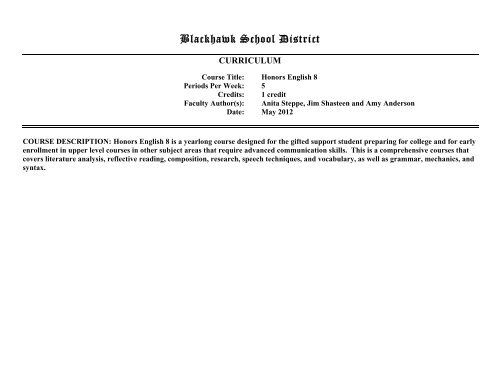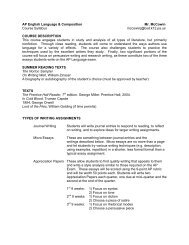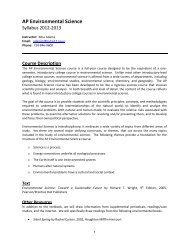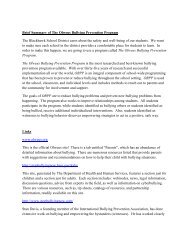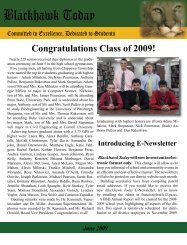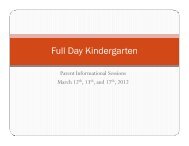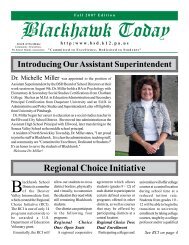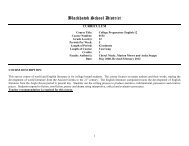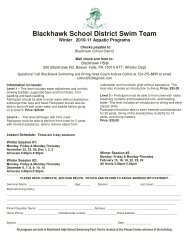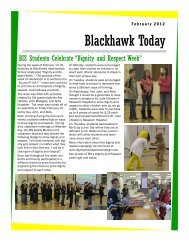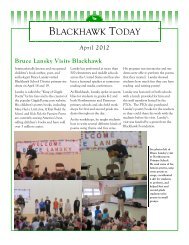Blackhawk School District
Blackhawk School District
Blackhawk School District
You also want an ePaper? Increase the reach of your titles
YUMPU automatically turns print PDFs into web optimized ePapers that Google loves.
<strong>Blackhawk</strong> <strong>School</strong> <strong>District</strong><br />
CURRICULUM<br />
Course Title: Honors English 8<br />
Periods Per Week: 5<br />
Credits: 1 credit<br />
Faculty Author(s): Anita Steppe, Jim Shasteen and Amy Anderson<br />
Date: May 2012<br />
COURSE DESCRIPTION: Honors English 8 is a yearlong course designed for the gifted support student preparing for college and for early<br />
enrollment in upper level courses in other subject areas that require advanced communication skills. This is a comprehensive courses that<br />
covers literature analysis, reflective reading, composition, research, speech techniques, and vocabulary, as well as grammar, mechanics, and<br />
syntax.
ESSENTIAL QUESTIONS:<br />
Essential questions are the heart of the curriculum. Essential questions are conceptual commitments that teachers will use to guide instructional<br />
decision-making. In addition, they are kid friendly so that students can easily understand them. Essential questions are meant to be shared with<br />
students in either discussion or posting in the classroom. Essential questions provide the focus for teaching and learning.<br />
Assessing Essential questions is key to a robust curriculum. If Essential Questions are the focal point of learning, how then do we assess students?<br />
The following are the Essential Questions for this class and an overview of recommended assessments to the Essential Questions. In addition,<br />
Differentiated learning opportunities are embedded as well.<br />
Writing: How can I communicate effectively?<br />
Assessment: Essay<br />
Where the Red Fern Grows: Have my circumstances ever changed? How have I dealt with my circumstances changing?<br />
Assessment: Essay<br />
“Flowers for Algernon”:<br />
Assessment: Essay<br />
Have my circumstances ever changed? How have I dealt with my circumstances changing?<br />
“The Diary of Anne Frank”: Have my circumstances ever changed? How have I dealt with my circumstances changing?<br />
Assessment: Essay<br />
“The Miracle Worker”:<br />
Assessment: Essay<br />
Have my circumstances ever changed? How have I dealt with my circumstances changing?
ROBUST VOCABULARY:<br />
Robust vocabulary words are Tier 2 words, meaning that they are complex, powerful, and generalizable. Robust vocabulary words support language<br />
development of both lower and high level learners. In addition, robust vocabulary instruction helps prepare students for SATs, upper level high<br />
school classes, and college. “Studies showed that robust instruction was quite effective not only for learning the meanings of words but also for<br />
affecting reading comprehension.” (p. 2 Bringing Words to Life).<br />
Teachers are asked to commit to teaching and students USING these words throughout the entire year. Using a variety of instructional strategies,<br />
students will learn the meaning of these words in a deep and meaningful way in this content and across other content areas.<br />
The Robust Vocabulary for this class are: *Note: In addition to the Robust Vocabulary words, Honors 8 has a large<br />
Quarter 1: epitome vocabulary-building component, therefore this list is not an inclusive list.<br />
Explicit<br />
implicit<br />
likewise<br />
moreover<br />
Quarter 2: despite<br />
antithesis<br />
cognizant<br />
compelling<br />
obscure<br />
Quarter 3: ensure<br />
nebulous<br />
paramount<br />
aversion<br />
augment<br />
Quarter 4: Anti<br />
Dis<br />
Inter<br />
Mid<br />
Mis<br />
Re<br />
Semi<br />
Sub<br />
Trans<br />
Un
COURSE OUTLINE OBJECTIVES (PA standard) RESOURCES<br />
FICTION<br />
E08.A-K.1.1<br />
Key ideas and details in<br />
literature<br />
E08.A-K.1.1.1 Cite textual evidence that most<br />
strongly supports an analysis of what the text says<br />
explicitly as well as inferences, conclusions, and/or<br />
generalizations drawn from the text.<br />
E08.A-K1.1.2 Determine a theme or central idea of a<br />
text and analyze its development over the course of<br />
the text, including its relationship to the characters,<br />
setting, and plot; provide an objective summary of<br />
the text<br />
Timeless Voices, Timeless Themes-Prentice<br />
Hall, 2005. ISBN 0-13-180433-2<br />
Measuring Up-Peoples Publishing, 2001.<br />
ISBN: 978-1-4138-6663-6W Reading,<br />
Level E<br />
The Miracle Worker<br />
Rawls, Wilson. Where the Red Fern Grows.<br />
New York: Bantam Books, 1961.<br />
ISBN: 0-553-27429-5<br />
LESSON<br />
REFLECTION<br />
(for future<br />
revisions)<br />
E08.A-C.2.1<br />
Craft and structure in<br />
literature<br />
E08.A-K.1.1.3 Analyze how particular lines of<br />
dialogue or incidents in a story, drama, or poem<br />
propel the action, reveal aspects of a character, or<br />
provoke a decision<br />
E08.A-C.2.11 Analyze how differences in the points<br />
of view of the characters and the audience or reader<br />
create effects as suspense or humor<br />
E08.A-C.2.1.2 Compare and contrast the structure of<br />
two or more texts and analyze how the differing<br />
structure if each text contributes to its meaning and<br />
style<br />
E08.A-C.2.1.3 Determine how the author uses the<br />
meaning of words or phrases, including figurative<br />
and connotative meanings, in a text; analyze the<br />
impact of specific word choices on meaning and tone,<br />
including analogies or allusions to other texts<br />
London, Jack. The Call of the Wild. New<br />
York: Bantam Books, 1981. ISBN: 0-553-<br />
21233-8.<br />
Flowers for Algernon<br />
The Diary of Anne Frank<br />
Orwell, George. Animal Farm. Austin:<br />
Holt, Rinehart and Winston, 1974. ISBN:<br />
0-03-055434-9<br />
The Diary of Anne Frank<br />
Rawls, Wilson. Where the Red Fern Grows.<br />
New York: Bantam Books, 1961.<br />
ISBN: 0-553-27429-5<br />
Flowers for Algernon<br />
Measuring Up-Peoples Publishing, 2001.<br />
ISBN:<br />
978-1-4138-6663-6W Reading, Level E
E.08.A-C.3.1<br />
Connections within, between,<br />
and/or among texts<br />
E08.A-V.4.1<br />
Figurative language in<br />
literature<br />
R8.B.2.1.1 R8.B.2.1.2<br />
Literary Terms/Figurative<br />
Language 1.3.8.C 1.3.8.D<br />
R11.B.1.1.1<br />
Tone, Style, Mood<br />
E08.A-C.3.1.1 Analyze how a modern work of<br />
fiction draws on themes, patterns of events, or<br />
character types form myths and traditional stories,<br />
including describing how the material is rendered<br />
anew<br />
E08.A-V.4.1.1 Determine or clarify the meaning of<br />
unknown and multiple-meaning words and phrases<br />
E08.A-V.4.11.a Use context clues<br />
E08.A-V.4.11.b Use Greek or Latin affixes and roots<br />
E08.A-V.4.1.2 Demonstrate understanding of<br />
figurative language, word relationships, and nuances<br />
in word meanings<br />
E08.A-V.4.1.2.a Interpret figures of speech in context<br />
E08.A-V.4.1.2.b Use relationships between words<br />
E08.A-V.4.1.2.c Distinguish among connotations and<br />
denotations<br />
1.3.8.D-Identify poetic forms such as ballads, sonnets<br />
and couplets.<br />
R8.B.1.1.1-Interpret, compare, describe, analyze, and<br />
evaluate the theme of fiction or literary nonfiction.<br />
-Interpret, compare, describe, analyze, and evaluate<br />
the relationship between the theme and other<br />
components of the text.<br />
1.3.8.E-Analyze how a scriptwriter’s use of words<br />
creates tone and mood, and how choice of words<br />
Rawls, Wilson. Where the Red Fern Grows.<br />
New York: Bantam Books, 1961.<br />
ISBN: 0-553-27429-5<br />
Flowers for Algernon<br />
Timeless Voices, Timeless Themes-Prentice<br />
Hall, 2005. ISBN 0-13-180433-2<br />
Flowers for Algernon<br />
Timeless Voices, Timeless Themes-Prentice<br />
Hall, 2005. ISBN 0-13-180433-2<br />
Measuring Up-Peoples Publishing, 2001.<br />
ISBN:<br />
978-1-4138-6663-6W Reading, Level E<br />
Measuring Up-Peoples Publishing, 2001.<br />
ISBN:<br />
978-1-4138-6663-6W Reading, Level E<br />
Timeless Voices, Timeless Themes-Prentice<br />
Hall, 2005. ISBN 0-13-180433-2
advances the theme or purpose of the work.<br />
R8.B.2.1.1-Identify, interpret, describe, and or<br />
analyze examples of personification, simile,<br />
metaphor, hyperbole, satire, imagery, foreshadowing,<br />
flashbacks, irony, mood, theme, and tone in text.<br />
R8.B.1.1.1-Interpret, compare, describe, analyze, and<br />
evaluate elements of the plot (conflict, rising action,<br />
climax and resolution)<br />
-Interpret, compare, describe, analyze and evaluate<br />
the relationship between elements of the plot<br />
(conflict, rising action, climax, resolution) and other<br />
components of the text.<br />
Rawls, Wilson. Where the Red Fern Grows.<br />
New York: Bantam Books, 1961.<br />
ISBN: 0-553-27429-5<br />
Timeless Voices, Timeless Themes-Prentice<br />
Hall, 2005. ISBN 0-13-180433-2<br />
The Diary of Anne Frank<br />
The Miracle Worker<br />
1.3.11.B R11.B.1.1.1<br />
Symbolism<br />
R8.A.1.1.2<br />
Synonym/antonym<br />
WRITING<br />
E08.C.1.1<br />
Write arguments to support<br />
claims with clear reasons and<br />
relevant evidence<br />
R11.B.1.1.1-Interpret, compare, describe, analyze,<br />
and/or evaluate the use of symbolism in fiction.<br />
-Interpret, compare, describe, analyze, and/or<br />
evaluate the relationship between symbolism and<br />
other components of the text.<br />
R8.A.1.1.2-Identify and apply a synonym or antonym<br />
or a word used in text.<br />
1.1.8.E.-Expand a reading vocabulary by identifying<br />
and correctly using idioms and words with literal and<br />
figurative meanings. Use a dictionary or related<br />
reference.<br />
E08.C.1.1.1 Introduce claims, distinguish claims<br />
from opposing claims, and support writer’s purpose<br />
E08.C.1.1.2 Support claims with evidence and<br />
sources<br />
E08.C.1.1.3 Create cohesion with words, phrases,<br />
Measuring Up-Peoples Publishing, 2001.<br />
ISBN:<br />
978-1-4138-6663-6W Reading, Level E<br />
Timeless Voices, Timeless Themes-Prentice<br />
Hall, 2005. ISBN 0-13-180433-2<br />
Timeless Voices, Timeless Themes-Prentice<br />
Hall, 2005. ISBN 0-13-180433-2
and clauses<br />
E08.C.1.1.4 Establish and maintain a formal style<br />
E08.C.1.1.5 Provide a concluding section<br />
E08.C.1.2<br />
Write<br />
informative/explanatory texts<br />
E08.C.1.2.1 Introduce a topic, organize ideas,<br />
concepts, and information using definition,<br />
classification, comparison, contrast, and cause/effect<br />
E08.C.1.2.2 Develop topic with facts, quotes, and<br />
definitions<br />
Language Network-McDougal Littell, 2001.<br />
ISBN 0-395-96738-<br />
E08.C.1.2.3 Use transitions<br />
E08.C.1.2.4 Use precise language and domainspecific<br />
vocabulary<br />
E08.C.1.2.5 Establish and maintain a formal style<br />
E08.C.1.2.6 Provide a concluding section<br />
E08.C.1.3<br />
Write narratives<br />
E08.C.1.3.1 Introduce characters, organize events,<br />
and maintain a point<br />
E08.C.1.3.2 Use dialogue, reflection, pacing, and<br />
description in writing<br />
E08.C.1.3.3 Use transitions<br />
Language Network-McDougal Littell, 2001.<br />
ISBN 0-395-96738-<br />
E08.C.1.3.4 Use precise words and sensory language<br />
E08.C.1.3.5 Provide a conclusion<br />
E08.E.1.1<br />
E08.E.1.1.1 Introduce texts, state a topic, and create
Draw evidence<br />
an organized structure in which ideas are grouped<br />
logically<br />
E08.E.1.1.2 Develop analysis through evidence to<br />
support claims, opinions, and inferences<br />
E08.E.1.1.3 Use transitions<br />
Language Network-McDougal Littell, 2001.<br />
ISBN 0-395-96738-<br />
E08.E.1.1.4 Use precise language and domainspecific<br />
vocabulary<br />
E08.E.1.1.5 Establish and maintain a formal style<br />
E08.E.1.1.6 Provide a concluding section<br />
1.5.8.E 1.5.8.F<br />
Revisions and editing<br />
1.5.8.F-Edit writing using the conventions or<br />
language by spelling all words correctly; using<br />
capital letters correctly; punctuating correctly; using<br />
parts of speech correctly; using complete sentences.<br />
1.5.8.E.-Revise writing to improve style, word<br />
choice, sentence variety and subtlety of meaning after<br />
rethinking how questions of purpose, audience and<br />
genre have been addressed.<br />
Language Network-McDougal Littell, 2001.<br />
ISBN 0-395-96738-<br />
1.2.8.C-Produce work in at least one literary genre<br />
that follows the conventions of the genre.<br />
1.4.8.D<br />
Keep Portfolio<br />
1.4.8.D.-Maintain a written record of activities,<br />
course work, experience, honors and interests.<br />
NON FICTION<br />
E08.B-K.1.1<br />
Key ideas and details in<br />
informational texts<br />
E08.B-K.1.1.1 Cite the textual evidence explicitly,<br />
inferences, conclusions and generalizations.
E08.B-K.1.1.2 Determine a central idea and analyze<br />
development, include relationship to supporting<br />
ideas; provide summary<br />
E08.B-K.1.1.3 Analyze how a text makes<br />
connections among and between individuals, ideas,<br />
or events (analogies, comparisons)<br />
Timeless Voices, Timeless Themes-Prentice<br />
Hall, 2005. ISBN 0-13-180433-2<br />
Measuring Up-Peoples Publishing, 2001.<br />
ISBN:<br />
978-1-4138-6663-6W Reading, Level E<br />
E08.B-C.2.1<br />
Craft and structure in<br />
informational texts<br />
E08.B-C.3.1<br />
Connections of informational<br />
texts<br />
E08.B-V.4.1<br />
Vocabulary and figurative<br />
language in informational<br />
texts<br />
E08.B-C.2.1.1 Determine author’s point or view or<br />
purpose and analyze how author acknowledges and<br />
responds to conflicting evidence or viewpoints<br />
E08.B-C.2.1.2 Analyze in detail the structure or a<br />
paragraph, including the role of particular sentences<br />
in developing and refining a key concept<br />
E08.B-C.2.1.3 Determine how the author uses the<br />
meaning of words or phrases, including figurative,<br />
connotative, or technical meanings, in a text; analyze<br />
the impact of specific word choices on meaning and<br />
tone, including analogies or allusions to other texts<br />
E08.B-C.3.1.1 Evaluate argument/claims, assess<br />
reasoning, recognize irrelevant evidence<br />
E08.B-C.3.1.2 Analyze conflicting<br />
facts/interpretation in two texts<br />
E08.B-V.4.1.1 Determine meaning of<br />
unknown/multiple-meaning words<br />
E08.B-V.4.1.1.a Context Clues<br />
The Diary of Anne Frank<br />
Rawls, Wilson. Where the Red Fern Grows.<br />
New York: Bantam Books, 1961.<br />
ISBN: 0-553-27429-5<br />
Timeless Voices, Timeless Themes-Prentice<br />
Hall, 2005. ISBN 0-13-180433-2<br />
Rawls, Wilson. Where the Red Fern Grows.<br />
New York: Bantam Books, 1961.<br />
ISBN: 0-553-27429-5<br />
Flowers for Algernon<br />
Measuring Up-Peoples Publishing, 2001.<br />
ISBN:<br />
978-1-4138-6663-6W Reading, Level E<br />
Timeless Voices, Timeless Themes-Prentice<br />
Hall, 2005. ISBN 0-13-180433-2<br />
Rawls, Wilson. Where the Red Fern Grows.<br />
New York: Bantam Books, 1961.<br />
ISBN: 0-553-27429-5<br />
Flowers for Algernon
E08.B-V.4.1.1.b Use Latin and Greek affixes and<br />
roots<br />
E08.B-V.4.1.1.c Determine the meaning of technical<br />
words<br />
Timeless Voices, Timeless Themes-Prentice<br />
Hall, 2005. ISBN 0-13-180433-2<br />
E08.B-V.4.1.2. Demonstrate understanding of<br />
figurative language, word relationships, and nuances<br />
in word meanings<br />
E08.B-V.4.1.2.a Interpret figures of speech in context<br />
E08.B-V.4.1.2.b Use the relationships between words<br />
to understand other words<br />
E08.B-V.4.1.2.c Distinguish denotations from<br />
connotations<br />
R11.B.1.1.1-Interpret, compare, describe, analyze,<br />
and/or evaluate the use of symbolism in literary<br />
nonfiction.<br />
-Interpret, compare, describe, analyze, and/or<br />
evaluate the relationship between symbolism and<br />
other components of the text.<br />
GRAMMAR<br />
E08.D.1.1<br />
Verbs, Clauses, Phrases,<br />
Pronouns<br />
E08.D.1.1.1Verbals – gerunds, participles, and<br />
infinitives<br />
E08.D.1.1.2 Active and Passive Voice Verbs<br />
E08.D.1.1.3 Verb forms – Indicative, imperative,<br />
interrogative, conditional, and subjunctive<br />
Language Network-McDougal Littell, 2001.<br />
ISBN 0-395-96738-<br />
E08.D.1.1.4 Recognize inappropriate shifts in verb<br />
voice and mood<br />
E08.D.1.1.5 Place phrases/clauses correctly. Identify
dangling modifiers<br />
E08.D.1.1.6 Recognize inappropriate shifts in<br />
number or person.<br />
E08.D.1.1.7 Recognize and correct vague pronouns<br />
E08.D.1.1.8 Recognize and correct inappropriate<br />
shifts in verb tense<br />
E08.D.1.1.9 Produce complete sentences, correct<br />
fragments and run-ons<br />
E08.D.1.1.10 Correctly use frequently confused<br />
words – to/too/two their/they’re/there<br />
E08.D.1.1.11 Ensure subject-verb and pronounantecedent<br />
agreement<br />
E08.D.1.2<br />
Capitalization, punctuation,<br />
and spelling<br />
E08.D.1.2.1 Use punctuation – comma, ellipsis, dash<br />
– to indicate a pause or a break<br />
E08.D.1.2.2 Use ellipsis to indicate an omission<br />
E08.D.1.2.3 Spell correctly<br />
E08.D.1.2.4 Use commas, parentheses, and dashes to<br />
set off nonrestrictive/parenthetical elements<br />
Language Network-McDougal Littell, 2001.<br />
ISBN 0-395-96738-<br />
E08.D.1.2.5 Use punctuation to separate items in a<br />
series<br />
E08.D.2.1<br />
Use knowledge of<br />
language/conventions<br />
E08.D.2.1.1 Use active, passive, conditional, and<br />
subjunctive verbs to emphasize action, express<br />
uncertainty, and describe contradictions
E08.D.2.1.2 Choose language that is concise<br />
E08.D.2.1.3 Vary sentence patterns<br />
Language Network-McDougal Littell, 2001.<br />
ISBN 0-395-96738-<br />
E08.D.2.1.4 Maintain consistency in style and tone<br />
E08.D.2.1.5 Choose punctuation for effect<br />
E08.D.2.1.6 Choose words/phrases for effect<br />
1.8.8.A 1.8.8.B 1.8.8.C<br />
Research<br />
1.8.8.A Select and refine a topic for research.<br />
1.8.8.B Locate information using appropriate library<br />
based sources including but not limited to Web<br />
Collection Plus, Newsbank, Infoweb, select databases<br />
from Power Library and Gale Virtual Reference<br />
Library.<br />
1.8.8.C-Select articles and/or information from Web<br />
Collection Plus, Newsbank, Infoweb, select databases<br />
from Power Library and Gale Virtual Reference<br />
Library; read and summarize one article from each of<br />
the following: Newbank, Infoweb, Facts for Learning<br />
and select databases from Power Library; create a<br />
works cited page using citation sheets and Noodle<br />
Tools.<br />
Pathfinder’s Project<br />
1.6.8.C 1.6.8.D 1.6.8.E<br />
Speaking/Listening in large<br />
and small group discussions<br />
and presentations<br />
1.6.8.A-Listen to others by asking clarifying<br />
questions, synthesizing information, ideas and<br />
opinions to determine relevancy, and taking notes.<br />
1.6.8.B.-Listen to selections of both fiction and<br />
nonfiction by relating them to previous knowledge;<br />
predicting solutions to identify problems;<br />
summarizing and reflecting on what has been heard;
identifying and defining new words and concepts;<br />
and analyzing and synthesizing the selections relating<br />
them to other selections heard or read.<br />
1.6.8.C-Speak using skills appropriate to formal<br />
speech situations by using a variety of sentence<br />
structures to add interest to a presentation; pace the<br />
presentation according to audience and purpose; and<br />
adjusting stress, volume and inflection to provide<br />
emphasis to ideas or to influence the audiences.<br />
1.6.8.D.-Contribute to discussions by asking relevant,<br />
clarifying questions, responding with relevant<br />
information or opinions to questions asked; listening<br />
to and acknowledge the contributions of others;<br />
adjusting tone and involvement to encouraging<br />
equitable participation; facilitating total group<br />
participation; introducing relevant, facilitating<br />
information, ideas and opinions to enrich the<br />
discussion.<br />
1.6.8.E.-Participate in small and large group<br />
discussions and presentations by initiating everyday<br />
conversations; selecting and presenting an oral<br />
reading on an assigned topic; conducting interviews;<br />
participating in a formal interview; organizing and<br />
participating in informal debate around a specific<br />
topic.<br />
R8.B.3.3.4-Identify, compare, explain, interpret,<br />
describe, and analyze the sequence of steps in a list of<br />
directions.<br />
Reading Skills<br />
Reading Apprenticeship<br />
Strategies<br />
Use of Reading Apprenticeship strategies including but<br />
not limited to Talking to the Text and Think Alouds will<br />
be used to aid student understanding of text.<br />
1.1.8.H-Demonstrate fluency and comprehension in
1.6.8.F R8.B.3.1.1<br />
R8.B.3.3.3<br />
Media, Propaganda, and<br />
Graphics<br />
reading by reading familiar materials aloud with<br />
accuracy; self-correct mistakes; use appropriate<br />
rhythm, flow, meter and pronunciation; reading a<br />
variety of genres and types of text; demonstrate<br />
comprehension.<br />
1.6.8.F- Use media for learning purposes by using<br />
various forms of media to elicit information, to make<br />
a student presentation and to complete class<br />
assignments and projects; evaluating the role of<br />
media in focusing attention and forming opinions;<br />
creating a multi-media presentation for display or<br />
transmission that demonstrates an understanding of a<br />
specific topic or issue or teaches others about it.<br />
1.1.8.A-Locate various texts, media and traditional<br />
resources for assigned and independent projects<br />
before reading.<br />
1.2.8.B-Use and understand a variety of media and<br />
evaluate the quality of material produced by selecting<br />
appropriate electronic media for research and<br />
evaluate the quality of the information received;<br />
explain how the techniques used in electronic media<br />
modify traditional forms of discourse for different<br />
purposes; use, design and develop a media project to<br />
demonstrate understanding.<br />
1.6.8.F-Use media for learning purposes by using<br />
various forms of media to elicit information, to make<br />
a student presentation and to complete class<br />
assignments and projects; evaluate the role of media<br />
in focusing attention and forming opinions; create a<br />
multi-media presentation for display or transmission<br />
that demonstrates an understanding of a specific topic<br />
or issue or teaches others about it.<br />
Timeless Voices, Timeless Themes-Prentice<br />
Hall, 2005. ISBN 0-13-180433-2<br />
The Miracle Worker<br />
Rawls, Wilson. Where the Red Fern Grows.<br />
New York: Bantam Books, 1961.<br />
ISBN: 0-553-27429-5<br />
Flowers for Algernon<br />
The Diary of Anne Frank
R8.B.3.3.3-Interpret and analyze graphics and charts,<br />
and make connections between text and the content<br />
of graphics and charts.<br />
CC.8.SL.2<br />
Analyze Media<br />
CC.8.SL.2 Comprehension and Collaboration:<br />
Analyze the purpose of information presented in<br />
diverse media and formats (e.g., visually,<br />
quantitatively, orally) and evaluate the motives (e.g.,<br />
social, commercial, political) behind its presentation
Grammar skills to be taught in 6 th , 7 th , and 8 th grades<br />
Combining sentences: Compound Subjects and Predicates<br />
o Use conjunctions /connecting words: “And”, “or”, “but” to combine parts of sentences. 6<br />
<br />
<br />
<br />
<br />
<br />
<br />
Combining sentences: Compound Sentences<br />
o Use conjunctions connecting words: “And”, “or”, “but”, “because”, “when”, “although”, and “since” to combine sentences. 7/8<br />
Combining sentences: Complex Sentences<br />
o Use subordinating conjunctions: i.e., “because”, “when”, “although”, and “since” to combine sentences. 8<br />
o Use relative pronouns: i.e., “who”, “whose”, “that”, “which”, “whom” to combine sentences. 8<br />
Prepositions<br />
o Identify and use prepositions, objects of prepositions, and prepositional phrases. 7<br />
Object Pronouns in Prepositional Phrases<br />
o Use object pronouns as the object of a preposition. 7<br />
Using Prepositions in Writing<br />
o Use prepositional phrases in the beginning of a sentence to add variety to writing. Place prepositional phrases in the<br />
appropriate place in writing. 7/8<br />
• Example:<br />
Wrong: She told about the high dive at breakfast.<br />
Correct: At breakfast, she told about the high dive.<br />
Capitalization<br />
o All sentences begin with a capital letter. 6/7<br />
o Grade 7: Capitalize the following appropriately:<br />
• Names and Initials<br />
• Titles (Dr., Mrs., etc..)<br />
• Abbreviations<br />
• President<br />
• Family Relationships<br />
• Pronoun “I”<br />
• Nationality, Languages, Races<br />
• Line of Traditional Poetry<br />
• Quotations
• Parts of a Letter<br />
• Literary, Musical, and Artwork Titles<br />
• Geographical Names<br />
• Bodies of the Universe<br />
• Regions and Sections of a Country / World<br />
• Building, Bridges, and Landmarks<br />
• Planes, Trains, and other Vehicles<br />
• Organizations and other Institutions<br />
• Historical Events, Periods, and Documents<br />
• Time Abbreviations and Calendar Events<br />
• Special Events, Awards, and Brand names<br />
<br />
<br />
<br />
<br />
<br />
<br />
<br />
<br />
Singular and Plural Nouns<br />
o All plural forms‐Add ‐s, ‐es, ‐ies and irregular nouns‐7R<br />
Singular Possessive Nouns<br />
o Start with singular form, add apostrophe “s” 7<br />
Plural Possessive Nouns<br />
o Start with the plural, if the plural ends in “s” just add Apostrophe<br />
o For plurals that don’t end with “s”, add apostrophe “s” 7<br />
Action Verbs<br />
o A verb may show action. 6R/7R/8R<br />
Linking Verbs<br />
o Linking Verbs: am, is, are, was, were, be, being, been, look, feel, taste, smell, sound, become, appear, remain, stay, seem, and<br />
grow. Example: The race will be quick. 6/7R/8R<br />
Helping Verbs<br />
o Use and identify helping verbs. 7<br />
• Example: The man has been traveling a lot.<br />
Present Tense Verbs<br />
o A verb that tells about now or in the present. 7<br />
Past Tense Verbs
o Past Tense Verbs and Irregular spelling patterns 7<br />
<br />
<br />
Future Tense Verbs<br />
o Distinction between shall and will. 7<br />
Regular and Irregular Verbs<br />
o Regular verbs add –ed to form the past and past participle. 7<br />
o Irregular verbs change their spelling to form the past and past participle and must be memorized. 7<br />
<br />
<br />
<br />
<br />
<br />
<br />
<br />
Past participles terminology<br />
o Understand the term principle parts: present, past, and past participle 7<br />
Present Perfect tense<br />
o Present Perfect tense includes have or has with the past participle.7<br />
• Examples: They have come to my house. He has run the race.<br />
Past Perfect<br />
o Past Perfect tense includes “had” with the past participle.7<br />
• Examples: He had just finished his homework when the telephone rang.<br />
Future Perfect<br />
o Future Perfect tense includes shall have or will have with the past participle. 7<br />
Verbs:<br />
o Use and identify indicative, imperative, interrogative, conditional, and subjunctive verbs. 8<br />
• Example: Indicative: I am going to the mall.<br />
• Example: Subjunctive: If I were you, I would run.<br />
• Example: Interrogative: Will you go with me?<br />
• Example: Conditional: I wish he would be kinder to me.<br />
• Example: Imperative: Close the door.<br />
Active and Passive Voice<br />
o Active Voice is when the subject performs the action. 8<br />
o Passive Voice expresses the action performed upon the subject. 8<br />
Adjectives
o An adjective describes a noun or pronoun. (It tells which one, how many, what kind, and how much) 7<br />
<br />
<br />
<br />
<br />
<br />
<br />
<br />
<br />
<br />
<br />
Adverbs<br />
o An adverb modifies a verb. (How?, When?, Where?, To what extent?, How much?, How often?) 7<br />
Comparing with Adverbs<br />
o Use comparing adverbs with ‐er, ‐est, or more / most and irregular (real, really, good, well) 7<br />
Adjective or Adverb<br />
o Use irregular adverbs (real, really, good, well, bad, badly) 7<br />
Negatives<br />
o Avoid double negatives. 7<br />
Subject‐Verb Agreement<br />
o Agreement with singular subject, plural subject, I and you. 7<br />
Subject Pronouns<br />
o Identify and use subject pronouns: I, you (singular), he, she, it, we, you (plural), they. 6<br />
• Example: My friend and I went to dinner.<br />
Object Pronouns<br />
o Identify and use object pronouns 6<br />
o Singular: me, you, him, her, it and<br />
o Plural: Us, you them<br />
• Example: Please call me tonight. Hand that pencil to me. Hand me that pencil.<br />
Possessive Pronouns<br />
o Identify and use possessive pronouns 6<br />
• Example: My book was stolen.<br />
Intensive Pronouns<br />
o Identify and use intensive pronouns 6<br />
• Example: The players, themselves, designed their uniforms.<br />
Indefinite Pronouns<br />
o Identify and use indefinite pronouns 6
• Example: Most of the players lost their uniforms.<br />
<br />
<br />
<br />
<br />
<br />
Pronoun and Antecedent Agreement<br />
o Identify pronoun and antecedent agreement. 6<br />
• Example: Amy bought her new purse.<br />
Contractions and Pronouns<br />
o Avoid using contractions as pronouns: its, it’s; their, they’re; your, you’re) 6<br />
Commas<br />
o Commas are used for the following purposes:<br />
• Introductory words: Yes, I am going to the game. 6/7<br />
• Greeting/Salutation and Closing: Dear Bob, / Sincerely, 6/7<br />
• Interjection: Oh, I guess I will go. 6/7<br />
• Nouns in Direct Address: Michelle, are you coming with us? 6/7<br />
• Appositive: My mother, Barb, is cooking dinner for us. 6/7<br />
• Interrupters: Joe, however, did not come to the party last night. 6/7<br />
• To avoid confusion: Before hieroglyphics, records were not kept on paper. 6/7<br />
• To separate adjectives of equal rank before a noun to modify: Both father and son made a quick, daring escape. 6/7<br />
o Commas are used to separate a list. 6/7<br />
• CORRECT: Eggs, bacon, and toast<br />
• INCORRECT: Eggs, bacon and toast<br />
o Identify and use commas correctly for nonrestrictive and parenthetical elements 6I/7<br />
• Example: The bridge, which was old, needed new steel beams.<br />
o Identify and use commas to separate coordinate adjectives 7<br />
• Example: It was a fascinating, enjoyable movie.<br />
o Identify and use commas to indicate a pause 8<br />
• Example: Into the house, crept the stalker.<br />
Direct Quotations<br />
o Use quotations marks and appropriate punctuation to identify dialogue. 6/7/8<br />
• Example: Captain Smith said, “Abandon the ship.”<br />
Indirect Quotation<br />
o Do not use quotation marks when using an indirect quote. 6/7/8<br />
• Example: Finally, Captain Smith told the radio operators that they should abandon their ship.
Divided Quotation<br />
o Use quotations around both parts of a divided quote. 6/7/8<br />
• Examples:<br />
“The ship,” the owner said, “is unsinkable.”<br />
“The ship is unsinkable,” said the owner. “It has extra protection because of its double bottom hull.”<br />
Parenthesis<br />
o Identify and use parenthesis for nonrestrictive and parenthetical elements 6<br />
• Example: She found safety in the home of the neighbors (they were peaceful Quakers) who bought out the remainder of<br />
her time as a slave.<br />
Dashes<br />
o Identify and use dashes for nonrestrictive and parenthetical elements 6<br />
• Example: She traveled all over the country—even to the White House—speaking about abolishing slavery.<br />
o Identify and use dashes to indicate a pause 8<br />
• Example: She traveled all over the country –even to the White House—speaking about abolishing slavery.<br />
<br />
<br />
<br />
<br />
<br />
Ellipsis<br />
o Identify and use ellipsis to indicate an omission. 8<br />
• Example: My friend … lost her homework.<br />
Phrases and Clauses<br />
o Identify phrases and clauses and use them correctly in writing. 8<br />
Dangling Modifier<br />
o Identify and use correctly. 8<br />
• Example: Running for the bus, my books fell in the mud.<br />
Verbals<br />
o Gerund—verb with “ing” used as a noun 8<br />
o Participles—verb with “ing” “ed” or irregulars used as an adjectives 8<br />
o Infinitives—“to” + verb used as nouns, adjectives, and adverbs 8<br />
Citations<br />
o Use punctuation in MLA citation accurately in works cited. 8


